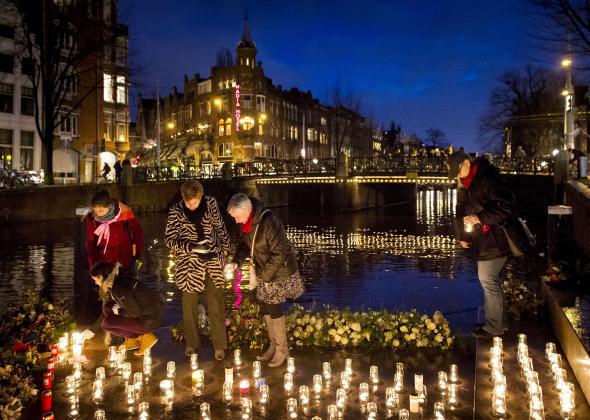When the world gathers at Auschwitz and other places across Europe and the United States on Tuesday to mark International Holocaust Remembrance Day and the 70th anniversary of the liberation of the camp, there will be a void. On June 24, 2012, Gad Beck, the man believed to be the last gay survivor of the Holocaust, died six days before his 89th birthday. He was the last living witness to and representative of a period of unparalleled persecution and suffering that cost the lives of thousands of gay men and destroyed thousands more.
It is estimated that between 5,000 and 15,000 gay men were detained in concentration camps under the Nazi regime, persecuted under Paragraph 175 of the German Criminal Code, which proscribed sexual acts between men. (In total, between 1933 and 1945, around 100,000 men were arrested under Paragraph 175, half of whom were sentenced.) While the Gestapo directive expanding incarceration beyond regular prisons was issued on April 4, 1938, gay men were among the first victims of the Holocaust to be rounded up and interned in concentration camps starting in 1933.
In Nazi Germany, the war on homosexuality was in part a moral one. It was a campaign against a vice associated with the decadence of the fallen Weimar Republic, upon whose ashes they were attempting to build not just a new society but a new man. The constructed image of the weak or effeminate homosexual male was held up as a mirror image of the heterosexual Aryan man, defender of the Fatherland, begetter of racially pure children. In that sense, homosexuality also represented an existential threat to the future of the German nation.
In Nazi ideology, homosexuality was not merely immoral, nor was it simply a set of acts defined in the penal code. Rather, it was a sickness, something that had to be cured. Homosexuals were separated from other prisoners in concentrations camps to prevent the spread of the “disease.” In Buchenwald, some were experimented upon with male hormones, a system of torture that yielded no medical gains. And, if the affliction couldn’t be cured, it would be erased. Castration became a kind of plea bargain, a humiliating, degrading way of avoiding the concentration camps.
For the 5,000 to 15,000 unable to escape the camps—Sachsenhausen, Buchenwald, and Mauthausen among others—work unto death was both cure and eradication. If the individual was not transformed by labor, labor erased the individual. Whether at the cement plant in Sachsenhausen, the underground V2 rocket factory in Buchenwald, or the stone quarry at Flossenbürg, homosexuals were subject to deadly assignments and a scarring, bone-shattering system of punishments. Sixty percent of gay internees died in the camps.
For those who remained alive, humiliation was an inevitable part of daily life. The Polish LGBTQ rights activist Robert Biedroń notes that homosexuals in the camps “were forced to sleep in nightshirts and to hold their hands outside the covers,” ostensibly in order to prevent masturbation. In Flossenbürg, homosexuals were required to visit female prostitutes—Jewish and Roma prisoners from a nearby camp—as a form of treatment. “The Nazis cut holes in the walls through which they could observe the ‘behavior’ of their homosexual prisoners,” Biedroń writes.
Gay victims of the Holocaust were not spared Auschwitz, a possible destination for German nationals imprisoned for their sexual orientation. (Eighty percent of those prosecuted under Paragraph 175 and sent to Auschwitz died there.) One such victim was Karl Gorath. Born in Bad Zwishenahn in northern Germany in December 1912, Gorath was 26 when a jealous lover denounced him as a homosexual to the authorities, which incarcerated him at Neuengamme, a subcamp of Sachsenhausen, near Hamburg.
During World War II, Gorath was transferred to Wittenberg, also a Sachsenhausen subcamp, and then to Auschwitz where he was labeled as a political prisoner, wearing a red triangle rather than a pink one, because he had refused to obey orders while working in the prisoner hospital at Wittenberg. At Auschwitz, Gorath claimed to have had a Polish lover named Zbigniew. He lived to see the liberation of the camp in January 1945 and later contributed to the documentary Paragraph 175, which featured the stories of six gay victims of Nazi persecution.
In collective memory, gay victims of the camps have long been neglected, but in the past few years memorialization has begun to recognize gay suffering. The Homomonument in Amsterdam, opened in 1987, is made of three pink granite triangles set into the ground that together form one larger triangle. One of its three corners points in the direction of the nearby Anne Frank House. Across the street from the Memorial to the Murdered Jews of Europe in Berlin stands the Memorial to Homosexuals Persecuted Under Nazism, a tilted, weathered gray cuboid with a window through which an art film of two men kissing can be viewed. In 2014 in Tel Aviv, outside the Gay Center in Gan Meir, a memorial consisting of three unconnected pink oblong blocks forming a triangle was opened. Its inscription reads, “In memory of those persecuted by the Nazi regime for their sexual orientation and gender identity.”
A memorial is but a substitute for the living witness. Whatever its shape, whatever its form, it cannot jolt us into remembrance and reflection as much as the human face, the human voice. Without men like Gad Beck and Karl Gorath, as we collectively become further removed from the Holocaust, what will happen to the memory of gay victims of the Holocaust? What happens on the 80th anniversary, the 90th, the 100th? Who will remember them then? We barely remember them now.
